 Last Updated February 9, 2025
Last Updated February 9, 2025
The most common Vitamix shopper’s question is some variant of, “I want to make smoothies, soups, and frozen desserts. Which Vitamix blender is best for me?” The answer is that all Vitamix machines work great for those tasks; which one is best depends on the volumes you want to blend and whether you want to pay for extra features.
If you don’t want to go through the nitty-gritty, here are my quick Vitamix recommendations:
Which is the best Vitamix model?
Best Value
- E310 (short/narrow container for small to medium amounts)
- Recon 5200 (tall/narrow container for small to large amounts)
- Recon E320 (short/wide container for medium to large amounts)
Money Is No Object
- Ascent X5 (latest and greatest)
The February 2025 shopping landscape
Most Vitamix models are on sale through Feb 22nd for the President’s Day Sale. Here is the sale.
Vitamix recently released a new set of Ascent models. Full details are in my Vitamix Ascent X Series Review.
The Food Processor Attachment gives more reason to consider Ascent and Venturist models, since it is not compatible with classic models. If you don’t care about the premium finish of the A3500, consider saving big on the Reconditioned Venturist.
If you are looking for the lowest possible price, I recommend choosing between the Recon 5200, the E310, and the Recon E320. The most significant difference between these models is the container they come with, so use the following Venn diagram to pick the optimal container for you. There are trade-offs between the three container options. To put it briefly, “short, narrow, or large capacity: pick 2”: 
Note to visitors from outside the United States: The model availability described on this page is for the USA (and APO/FPO addresses). If you are shopping from Canada, check out my page about Canadian Vitamix models.
For most people, I recommend choosing from the following four categories: Certified Reconditioned models, Explorian, Premium Classic, and Ascent.
Reconditioned
 If you are looking for the lowest possible price on Vitamix, reconditioned is for you. Some people are hesitant to buy reconditioned, and that is a valid concern with some companies, but Vitamix’s reconditioned units are guaranteed to be top quality. The only reasons I would avoid reconditioned Vitamix are if it is for a gift for someone who won’t understand, or if you want some of the features not available on reconditioned machines.
If you are looking for the lowest possible price on Vitamix, reconditioned is for you. Some people are hesitant to buy reconditioned, and that is a valid concern with some companies, but Vitamix’s reconditioned units are guaranteed to be top quality. The only reasons I would avoid reconditioned Vitamix are if it is for a gift for someone who won’t understand, or if you want some of the features not available on reconditioned machines.
Explorian
 If you prefer a slightly smaller container, I highly recommend the new E310, which comes with a short and narrow 48-oz container (full review). The Explorian E320 is functionally identical to the E310, but it comes with a wide container. That makes it nearly identical to the 5300. (The E320 replaces the 5300 in the model lineup, and it is mostly the same, with a few changes: it does not have the on-off switch on the side, and it does not light up when on. I don’t think these differences matter much, but there they are for anyone wondering about E320 vs. 5300.)
If you prefer a slightly smaller container, I highly recommend the new E310, which comes with a short and narrow 48-oz container (full review). The Explorian E320 is functionally identical to the E310, but it comes with a wide container. That makes it nearly identical to the 5300. (The E320 replaces the 5300 in the model lineup, and it is mostly the same, with a few changes: it does not have the on-off switch on the side, and it does not light up when on. I don’t think these differences matter much, but there they are for anyone wondering about E320 vs. 5300.)
There is now also an Explorian E520, which comes with the wide 64-oz container and adds 3 preset blending modes. With the hidden discount that gets activated after clicking a Vitamix link on this site and then adding the Recon E520 to your shopping cart, it is an excellent deal.
Premium Classic and Propel
If you want the most premium machine, but don’t want the new technology of Ascent, then the Professional Series 750 is for you. I think the Ascent machines are quite nice, but you might not like the look of their digital display, or you might want to be able to use older containers (without NFC chips).
In 2023 Vitamix released a new Series, which they are calling the Propel. Similar to the Pro 750, these machines have preset modes and a secondary on-off switch. The Propel machines also have the subtly updated styling that was released with the Explorian series: Propel 510 and Propel 750.
Ascent (Smart System Blenders)
If you want to buy into the future of Vitamix, the Ascent Series is the way to go. It’s priced in the same range as new Legacy models, but it comes with various upgrades (among them: longer warranty, timer display, can use small cups without bulky adapter, and a wireless connection to smartphone app).

 Within the Ascent Series, the A2300 is the lowest-priced model and it has everything you need. (If you’re buying reconditioned, the A2500 is the lowest-priced model, and it has all the features of the A2300, including full variable speed control, and it adds 3 preset program modes.) If you feel like upgrading, I recommend going all the way up to the A3500, because it has premium finish options. (I’m not saying that the intermediate Ascent models are a bad choice, they just wouldn’t be my choice.) See my Ascent review page for more details.
Within the Ascent Series, the A2300 is the lowest-priced model and it has everything you need. (If you’re buying reconditioned, the A2500 is the lowest-priced model, and it has all the features of the A2300, including full variable speed control, and it adds 3 preset program modes.) If you feel like upgrading, I recommend going all the way up to the A3500, because it has premium finish options. (I’m not saying that the intermediate Ascent models are a bad choice, they just wouldn’t be my choice.) See my Ascent review page for more details.
If you’ve been putting off getting a Vitamix because you’re saving up, you can get one right away with a payment plan. If you make on-time payments, there are zero financing fees.
You can leave a comment below or contact me if you are still having trouble deciding which one to get.
Comparison of pre-Ascent models follows
If you want to quickly see the relation between all of the different Vitamix models, you can jump ahead to my comparison chart.
I made an interactive tool to help explore the different features. Try playing with it to get a sense of which you are interested in. You can click any model to go to its Vitamix.com page, or you can read more about the different models below.
+ Show model selection tool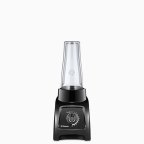 Recon S30
Recon S30  Recon 2-Speed
Recon 2-Speed  Recon 5200
Recon 5200  Recon 5300
Recon 5300  Recon Pro 500
Recon Pro 500 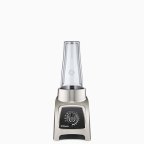 Recon S55
Recon S55  S30
S30  2-Speed
2-Speed 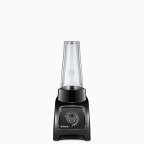 S50
S50  Recon 7500
Recon 7500  5200
5200  S55
S55 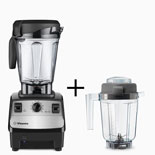 Recon 5300 + 32oz
Recon 5300 + 32oz  Recon Pro 750
Recon Pro 750  7500
7500  Pro 500
Pro 500  Recon 7500 + 32oz
Recon 7500 + 32oz  Pro 750
Pro 750 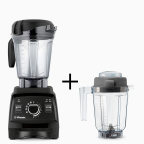 Recon Pro750+32oz
Recon Pro750+32oz  7500 + 32oz
7500 + 32oz  Pro 750 + 32oz
Pro 750 + 32oz  780
780 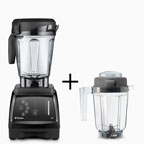 780 + 32oz
780 + 32oz(If you want the 32-oz container, you have to add it to your cart separately: 32-oz container link)
If you’re overwhelmed by the choices and just want to know my preference, I’ve used all of the different types of Vitamix blenders, and before I started using Ascent, the one I used on a daily basis was the 7500, with an extra 32-oz container for blending smaller amounts. (For the best deal, check out certified reconditioned.) All of the models are excellent, and I don’t think there is a wrong choice. (Plus, if you change your mind in the first 30 days, you can get a full refund, including free shipping both ways.)
Summary of Differences
These are the five key decisions to make when deciding which Vitamix to buy:
The following comparison chart shows the relations between the different machines in the S-Series, C-Series, and G-Series. The machines within most boxes of the chart are identical, but they come with different accessories and cookbooks (the exceptions are the S50 and S55, where the S55 has 2 more presets than the S50, and the Pro 750 and Vitamix 780, where the 780 has a flat touchpanel control). Generally the differences in accessories/cookbooks are pretty marginal, so I’d recommend going for the lowest price model within the box.

(“+” indicates there are also more expensive options in addition to the price listed in the chart. The following machines are not shown because they do not fit in with the rest: the Vitamix Turboblend Two Speed and Three Speed lack variable speed control, and the Vitamix 5300 and 6500 are a hybrid of the 6300 and 7500—i.e. they have a 7500 container on a 6300 base, without or with presets.)
Personal Blender? (S-Series vs. C-Series and G-Series)
(Vitamix S30 and S55 vs. 5200, 7500, et al.)
 In 2014 Vitamix released the Vitamix S30. It is smaller than the other Vitamix models, and also comes with a combination blending container/to-go smoothie cup. The Vitamix S50 and Vitamix S55 came out in 2015, and they are the same as the S30 but add preset modes. Since these models are significantly different from all the other models, I put up a detailed Vitamix S30 and S-Series review. If you are considering a smaller blender, or like the idea of blending in a to-go smoothie cup, you should check them out. Not surprisingly, the S-Series’ smaller size means that their maximum capacity is lower the other models (40 oz vs 64 oz).
In 2014 Vitamix released the Vitamix S30. It is smaller than the other Vitamix models, and also comes with a combination blending container/to-go smoothie cup. The Vitamix S50 and Vitamix S55 came out in 2015, and they are the same as the S30 but add preset modes. Since these models are significantly different from all the other models, I put up a detailed Vitamix S30 and S-Series review. If you are considering a smaller blender, or like the idea of blending in a to-go smoothie cup, you should check them out. Not surprisingly, the S-Series’ smaller size means that their maximum capacity is lower the other models (40 oz vs 64 oz).
Variable Speed?
(Vitamix Two Speed vs. 5200 and Vitamix 6000 vs. 6300)
 The variable speed control found on all Vitamix machines except for the Two Speed and 6000 is useful for when you don’t want to fully liquefy your blend. Examples are pesto, salsa, or chopping vegetables. If you don’t have variable speed, you can get away with quickly pulsing, but you won’t have quite as much control. The variable speed also makes the “bubble removal trick” more effective, although pulsing on low speed also works.
The variable speed control found on all Vitamix machines except for the Two Speed and 6000 is useful for when you don’t want to fully liquefy your blend. Examples are pesto, salsa, or chopping vegetables. If you don’t have variable speed, you can get away with quickly pulsing, but you won’t have quite as much control. The variable speed also makes the “bubble removal trick” more effective, although pulsing on low speed also works.
Preset Programs?
(Vitamix Two Speed vs. 6000, Vitamix 5200 vs. 6300, Vitamix Professional Series 200 vs. Professional Series 500, Vitamix S30 vs. S55, and Vitamix Professional Series 300 vs. Professional Series 750)
 The preset programs on the 6000, 6300/Pro 500, S55, and Pro 750 allow you to select a program, turn it on, and then the machine will automatically ramp up the speed and then shut off after a certain amount of time. There are a number of reasons that people appreciate this function:
The preset programs on the 6000, 6300/Pro 500, S55, and Pro 750 allow you to select a program, turn it on, and then the machine will automatically ramp up the speed and then shut off after a certain amount of time. There are a number of reasons that people appreciate this function:
• You can start the machine and “walk away” to do something else.
• If you strictly follow recipes the presets can yield more consistent results.
• Presets can give new users more confidence with the machine.
However, the presets do not work perfectly every time. Sometimes ingredients require tamping to start circulating past the blades, so you can’t always “walk away.” Also, the preset time might not be the optimum blending time if you modify a recipe. You may find that your smoothie is not fully blended after the smoothie program runs, so you have to run it again. A commercial coffee or smoothie shop makes the same recipes over and over, so in that setting presets are extremely useful. If you constantly make new combinations and of differing amounts, as many home users do, the settings may be less useful. It’s not too hard to tell when something is sufficiently blended, and after a few trials anyone should be able to figure it out. For these reasons, I personally would not pay extra for the preset settings. However, I know many people who have the presets love them. One thing to remember is that the machines with presets still have the variable speed knob for full manual control. If you don’t mind the added cost of presets, you can always switch back and forth to manual control.
C-Series vs. G-Series (Next Generation)?
(Vitamix 5200 vs. 7500, and Vitamix Professional Series 500 vs. Professional Series 750)
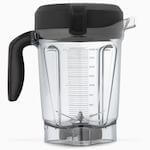 Vitamix released the “Next Generation,” aka “G-Series,” models in 2012. Both the base and the pitcher have an updated design. The base has slightly better sound muffling and also has better airflow which means that it can work harder before it overheats. To go with the better-cooled motor, the updated pitcher has a 4-inch blade instead of the Standard/Classic “C-Series” 3-inch blade. The 4-inch blade is in a shorter and wider container that has the same capacity as the 64-oz C-Series container.
Vitamix released the “Next Generation,” aka “G-Series,” models in 2012. Both the base and the pitcher have an updated design. The base has slightly better sound muffling and also has better airflow which means that it can work harder before it overheats. To go with the better-cooled motor, the updated pitcher has a 4-inch blade instead of the Standard/Classic “C-Series” 3-inch blade. The 4-inch blade is in a shorter and wider container that has the same capacity as the 64-oz C-Series container.
Advantages of the wider design:
• less need for the tamper (ingredients fall into the blades more easily)
• better chopping capability (you can course-chop more ingredients at a time)
• easier to scrape thick mixtures out
Advantage of shorter design:
• easier storage (at 17.5” tall, the container with lid on the base fits under standard kitchen cabinets)
Advantages of the 4-inch blade:
• faster processing time
• under some circumstances, marginally smoother blends
The one disadvantage of the new container is that for small volumes of under ~2 cups it does not work quite as well as the C-Series narrow container. The G-Series wider design causes two things to happen. First, there is more splashing up onto the inside of the lid and upper walls of the container, which means you lose a small amount of your blend unless you carefully scrape off the lid and walls. Second, you need slightly more volume to cover the blades and get good circulation going. The minimum volume to blend depends on what you are blending, and also on how much effort you are willing to spend pushing ingredients back into the blades. For example, for best results, the narrow containers can make nut butter easily by starting with 3 cups of nuts, whereas the wider Next Generation containers do best with 4 cups of nuts. For easier, more liquidy, blends, you can go below 1 cup in either container, but Next Generation containers will splash around more.
This disadvantage is a non-issue if most of your blends are over 2 cups, or if you are willing to spend a bit more to buy an additional narrow container, which will give you the best of both worlds. I like the 32-oz container for this purpose, although the 48-oz container has the same narrow bottom so it works just as well. The 48-oz container is just a bit bulkier on the outside because it sits outside the centering posts instead of inside of them, and its top is wider as well.
(The narrow C-Series Vitamix containers are compatible with G-Series models, but the G-Series containers are not recommended for use on C-Series models. The longer G-Series blades increase the load, and Vitamix does not recommend the C-Series cooling system for those increased loads.)
Reconditioned?
 Buying reconditioned is a great way to save money. For more details on deciding about buying reconditioned, see my refurbished Vitamix page.
Buying reconditioned is a great way to save money. For more details on deciding about buying reconditioned, see my refurbished Vitamix page.
Continue on for more details of each model type…
The array of different Vitamix blenders is a bit confusing, but it turns out that there is a lot of redundancy between the different models. I am only discussing models made for consumer/home use. Their commercial blenders are not ideal for home use because they are generally more expensive and have shorter warranties (3 years vs 7 years for home use; they are warrantied for constant use—think of how many times per day a blender at Jamba Juice runs compared to at your home).
The Vitamix website currently lists over 30 different home models, but they are all variants of three main designs: “personal” (S-Series), “standard/classic” (C-Series), and “next generation” (G-Series). For each of these main designs there are a few different options, to make a total of 8 different machine types. The rest of the models have identical bases, but come with different containers and/or accessories.
S-Series Motors
If the smaller size, dishwasher safe container, and “to-go” blending container appeal to you, please read the full details at my Vitamix S30, S50, and S55 review. For quick reference, the size of the base is 8.3″ deep x 5.9″ wide x 7.7″ tall. With the 20-oz to-go container the total height is 14.55″. The height is 15.66″ with the 40-oz container. These models have lower power, but they are still capable of making all of the usual Vitamix creations, just in smaller quantities.
C-Series Motors (Standard/Classic)
There are three types of bases of the standard variety. The differences are in the controls. The dimensions of the base of these machines are 8.75″ deep x 7.25″ wide x 8.25″ tall. There are three different container size options: 32 oz, 48 oz, and 64 oz, which result in height of base plus container/lid of 16.9″, 17.4″, and 20.5″ respectively.
Standard, no-variable speed (Vitamix TurboBlend Two Speed and Three Speed)
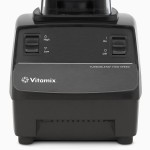 TurboBlend Two Speed (
TurboBlend Two Speed ($399$349); reconditioned for $299. This machine comes with a 5-year warranty and lacks the variable speed knob. Variable speed is useful for cases where you want to have finer control over the texture (i.e. if you don’t want a totally smooth purée). However, you can accomplish some non-liquefying chopping tasks by quickly pulsing the machine. While this is the most affordable new machine, I’d highly recommend looking at the reconditioned 5200, which has the same warranty and adds variable speed for $70 less.
In May 2016 Vitamix came out with a new no-variable speed machine, the TurboBlend Three Speed($499). It is exactly what it sounds like: it has three speed settings: low, medium, and high. It also has a pulse switch, which does the same thing as switching the start-stop button on and off. The pricing on this model is a bit strange, since for $50 less you can get a machine with fully variable speed. Plus, the TurboBlend 3-Speed comes with a 5-year warranty, instead of the 7 years on machines like the 5200.
Standard variable speed (Vitamix 5200 et al.)
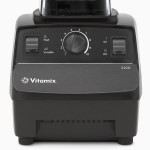 Until recently this was Vitamix’s bread and butter, and they have a lot of models to show for it: 5200 ($449), TurboBlend VS (retired), CIA Pro (retired), Pro 200 ($499), Creations II ($449), and Creations GC (retired); reconditioned for $329. These machines are essentially identical. Some are available with a shorter 48-oz container instead of the 64-oz container. The smaller container is nice because it’s more compact (and fits under standard kitchen cabinets), but of course its capacity is lower. The aesthetics of the switches and dial are slightly different between the different models. The Creations models come with a 5-year warranty, while the rest are 7 years. The 5200 comes with their “whole foods cookbook,” the TurboBlend VS comes with a vegetarian/vegan/raw cookbook and a nutmilk straining bag, the Pro models come with a cookbook with restaurant-oriented recipes (the CIA one—that’s Culinary Institute of America—comes with an additional recipe book). Note that if you buy reconditioned, you cannot choose which of the Standard models you are getting; Vitamix will choose for you based on availability, but remember that functionally they are identical.
Until recently this was Vitamix’s bread and butter, and they have a lot of models to show for it: 5200 ($449), TurboBlend VS (retired), CIA Pro (retired), Pro 200 ($499), Creations II ($449), and Creations GC (retired); reconditioned for $329. These machines are essentially identical. Some are available with a shorter 48-oz container instead of the 64-oz container. The smaller container is nice because it’s more compact (and fits under standard kitchen cabinets), but of course its capacity is lower. The aesthetics of the switches and dial are slightly different between the different models. The Creations models come with a 5-year warranty, while the rest are 7 years. The 5200 comes with their “whole foods cookbook,” the TurboBlend VS comes with a vegetarian/vegan/raw cookbook and a nutmilk straining bag, the Pro models come with a cookbook with restaurant-oriented recipes (the CIA one—that’s Culinary Institute of America—comes with an additional recipe book). Note that if you buy reconditioned, you cannot choose which of the Standard models you are getting; Vitamix will choose for you based on availability, but remember that functionally they are identical.
Sometimes these models are listed with their color-specific SKU. All of the following models are identical to the 5200, they just come with different colors and names: Vitamix 1709, 1363, 1364, 1365, 1709, 1723, 1732. They also sometimes go by VM0103. Vitamix 1978 is also the same, but comes with a 48-oz container.
Standard variable speed + presets (Vitamix 6300 and Professional Series 500)
 Pro 500 ($559) and 6300 (retired); reconditioned for $379. These are the same model; the only difference is that the 6300 comes with the “Savor” cookbook, which has a broader range of recipes than the Pro 500’s “Create” cookbook, which focuses more on restaurant-style recipes that tend to be richer.) They have 3 preset programs that run the blender for a certain amount of time and speed for smoothies, frozen desserts, and hot soups. Their switches are slightly different from the non-preset models. The non-preset models have an on-off switch, a variable speed knob, and a high-variable speed switch. The preset ones have moved the highest speed setting onto the knob and replaced the high-variable speed switch with a pulse switch. This is really a minor aesthetic difference, since you can achieve pulsing on the non-preset models by quickly flicking the on-off switch on and off.
Pro 500 ($559) and 6300 (retired); reconditioned for $379. These are the same model; the only difference is that the 6300 comes with the “Savor” cookbook, which has a broader range of recipes than the Pro 500’s “Create” cookbook, which focuses more on restaurant-style recipes that tend to be richer.) They have 3 preset programs that run the blender for a certain amount of time and speed for smoothies, frozen desserts, and hot soups. Their switches are slightly different from the non-preset models. The non-preset models have an on-off switch, a variable speed knob, and a high-variable speed switch. The preset ones have moved the highest speed setting onto the knob and replaced the high-variable speed switch with a pulse switch. This is really a minor aesthetic difference, since you can achieve pulsing on the non-preset models by quickly flicking the on-off switch on and off.
Some people love the presets because you can set it and walk away (assuming the mixture is circulating and you don’t need the tamper), and because they get more consistent results. However, the more consistent results will only hold if you always add the same quantities and types of items to the blender. For example, if you’re making a small smoothie, you can blend it for less time than if you were making a large one. One other thing is that you can set the non-preset machines and walk away—you just have to come back to stop them. I often use the blending time to rinse off the knife and cutting board that I used. You’re not likely to forget that the Vitamix is running because it’s loud enough to hear throughout the house. The variable speed knob goes to the same high speed as the previous models on high, but it’s lowest setting is a bit faster than on the 5200 et al., so you lose a tiny bit of fine control. Whether the presets are worth it is a personal question—I wouldn’t pay extra for them, but some people love them.
Standard no variable speed + presets (Vitamix 6000)
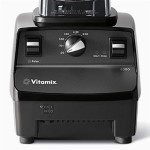 6000 (retired). Released October 2013, this is more of a mash-up of existing machines than a truly new one. It’s a sort of blend between the Two Speed, and the 6300. It does not have variable speed control, but it has six preset timed blending settings. These settings will automatically ramp up the speed, and then turn it off after a specified time of 20 sec, 30 sec, 1 min, 1.5 min, 4.5 min, or 6.5 min. Like the 6300, the pulse control is spring-loaded so that it only stays on as long as you hold it down, and it blends at a medium-low speed.
6000 (retired). Released October 2013, this is more of a mash-up of existing machines than a truly new one. It’s a sort of blend between the Two Speed, and the 6300. It does not have variable speed control, but it has six preset timed blending settings. These settings will automatically ramp up the speed, and then turn it off after a specified time of 20 sec, 30 sec, 1 min, 1.5 min, 4.5 min, or 6.5 min. Like the 6300, the pulse control is spring-loaded so that it only stays on as long as you hold it down, and it blends at a medium-low speed.
G-Series Motors (Next Generation)
In 2012 Vitamix released a new generation G-Series base with improved airflow that makes it run cooler and quieter than the classic C-Series one. With the improved cooling, the G-Series base can use a new pitcher design that is wider and has longer blades. This design makes the tamper less necessary, and makes it easier to get thick mixtures out. The longer blades also process food faster and work better for chopping. The G-Series machines are compatible with the C-Series containers, so if you want to use the dry blade you can use the same classic dry container. Dimensions are 9.4″ deep x 7.7″ wide x 17.5″ tall (with new-style 64-oz container in place). For more details of sizes, check out the PDF footprints I made for my Vitamix S30 review.
Next generation motor (Vitamix 7500, Professional Series 300, and Creations Elite)
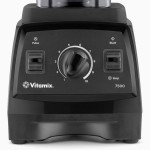 7500 ($529), Creations Elite ($557.50), and Pro 300 ($559); reconditioned for $439. These are all the same machine, so don’t worry about the note on the Reconditioned Next Gen page that says that the label may reflect any of these models. The only difference is the name printed on it. One point of confusion is that the Creations Elite is sold new with a smaller container, but if you happen to get sent a Creations Elite as a Reconditioned Next Gen, it will come with the same low profile 64-oz container that the 7500 comes with.
7500 ($529), Creations Elite ($557.50), and Pro 300 ($559); reconditioned for $439. These are all the same machine, so don’t worry about the note on the Reconditioned Next Gen page that says that the label may reflect any of these models. The only difference is the name printed on it. One point of confusion is that the Creations Elite is sold new with a smaller container, but if you happen to get sent a Creations Elite as a Reconditioned Next Gen, it will come with the same low profile 64-oz container that the 7500 comes with.
Next generation motor + presets (Vitamix Professional Series 750 and Vitamix 780)
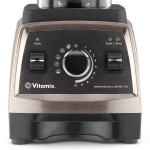
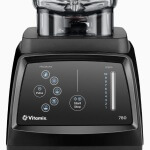 Pro 750 ($599–$649), 780 ($719); available reconditioned: 750 for
Pro 750 ($599–$649), 780 ($719); available reconditioned: 750 for $519–$569$499, and 780 for $519$399. These models have 5 presets: smoothies, frozen desserts, purées, hot soups, and self-washing. If you want to see more details of exactly what the presets do, check out my page about demystifying Vitamix presets. The 780 is identical, except that it has a touchpanel control interface. See my Vitamix 780 review for more details.
Vitamix Heritage 750 vs. Original 750?
In late 2015, Vitamix released a new version of the Pro 750: the Heritage line. The Vitamix Heritage 750 is functionally equivalent to the original Pro 750, but it has two differences on the exterior of the base. The upper shell (see diagram below) is now metal on the Heritage models. The Vitamix website doesn’t put Heritage in the model title, but it’s there in the description.
 The original 750 came in a brushed stainless finish option, but the upper shell was plastic with a thin metallic coat that could be scratched or scuffed. (When I tested the original 750 for a couple of months, I did not see any problems, but I have heard that some people have noticed scratches/scuffs.) The solid metal of the new Heritage models is more durable. Also, the metal shell muffles the the motor a bit more than the plastic, making the Heritage models a bit quieter.
The original 750 came in a brushed stainless finish option, but the upper shell was plastic with a thin metallic coat that could be scratched or scuffed. (When I tested the original 750 for a couple of months, I did not see any problems, but I have heard that some people have noticed scratches/scuffs.) The solid metal of the new Heritage models is more durable. Also, the metal shell muffles the the motor a bit more than the plastic, making the Heritage models a bit quieter.
 The other minor difference is that the Heritage models’ front panel has fewer backlights: Heritage models light up the indicators above the pulse and start-stop switches, whereas the original Pro 750 has backlights around the central knob as well.
The other minor difference is that the Heritage models’ front panel has fewer backlights: Heritage models light up the indicators above the pulse and start-stop switches, whereas the original Pro 750 has backlights around the central knob as well.
The Heritage metal is available in brushed stainless and copper finishes. (Currently on Vitamix.com, the Heritage options are listed on the main Pro 750 page, and the old brushed stainless finish is discontinued.)
I believe it is called Heritage because it is a throwback to the original Vitamix models that had all-metal bases. The plastic that Vitamix has been using for their bases for the past 25 years is extremely durable, so this change won’t affect functional longevity. That said, the elegant finish of the Heritage models will now likely stay unblemished for longer. It’s also nice that Vitamix did not increase the price for this upgrade.
The Vitamix 5300 and 6500
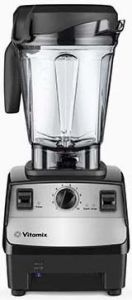 5300 ($529) and 6500 ($599); reconditioned for $360. Vitamix does not currently sell the new models online, only the reconditioned one. These are “new” models for 2015, although they are actually just slightly unexpected mash-ups of previous models. They are a hybrid between a 6300 and a 7500. They use the wide Next Gen (G-Series) container but they have a Classic (C-Series) base. The 5300 has variable speed and a pulse control switch, and has no presets. Meanwhile, the 6500 has the same three presets as the 6300. (Further evidence of equivalence between the 5300/6500 and C-Series models is on the Reconditioned C-Series 6300/Pro 500 page: it says its base may be a 6500.)
5300 ($529) and 6500 ($599); reconditioned for $360. Vitamix does not currently sell the new models online, only the reconditioned one. These are “new” models for 2015, although they are actually just slightly unexpected mash-ups of previous models. They are a hybrid between a 6300 and a 7500. They use the wide Next Gen (G-Series) container but they have a Classic (C-Series) base. The 5300 has variable speed and a pulse control switch, and has no presets. Meanwhile, the 6500 has the same three presets as the 6300. (Further evidence of equivalence between the 5300/6500 and C-Series models is on the Reconditioned C-Series 6300/Pro 500 page: it says its base may be a 6500.)
The reconditioned 5300 is the most affordable option for a machine with the short/wide container.
The strange thing about these models is that previously Vitamix stated that Next Gen containers should not be used on Classic bases because they do not have the updated airflow design that cools the motor more effectively.
I strongly suspect that the 5300 has the same microprocessor speed control as the 7500, Pro 750, and 6300, just without the presets. (You can read about the speed control of the different machines on my Vitamix RPM measurement page.) The microprocessor speed control should help protect the motor when using the wide container at high loads and very low speeds, but at maximum speed it shouldn’t make a difference. The marketing copy for the 5300 says that it comes “with a faster, yet quieter, motor,” but I am skeptical of those claims [Update: interestingly, Vitamix removed that phrase].
The 5300 and 6500 are a bit louder than the G-Series bases, which have sound-dampening technology not present in the C-Series bases. At the same price point, I would prefer the 7500.
Satisfaction Guarantee
Vitamix has a 30-day satisfaction guarantee, so if you have second thoughts you can return a machine within the first 30 days for a full refund and they even pay return shipping.
Warranty
If your machine has any problems during the warranty period of 5 or 7 years, Vitamix will repair or replace it, and they cover shipping costs both ways. For more details about warranties, check out my Vitamix Warranty page.
Reconditioned Vitamix
 I know I already mentioned reconditioned machines, but I want to restate what a great deal I think they are. These factory-refurbished machines offer the best prices you’ll find on Vitamix: 5200 for $329, Pro 500 for $379, and 7500 for $439. For more details, see my refurbished Vitamix page.
I know I already mentioned reconditioned machines, but I want to restate what a great deal I think they are. These factory-refurbished machines offer the best prices you’ll find on Vitamix: 5200 for $329, Pro 500 for $379, and 7500 for $439. For more details, see my refurbished Vitamix page.
Payment Plans
Want to start blending right away, but don’t want to pay the full price up front? Vitamix offers payment plans with zero interest and no fees if you make payments on time. For more information, check out my payment plan page.
Free Shipping
Clicking on any Vitamix link on this page will automatically apply a promotion code, which gives you free shipping on your order of a Vitamix machine (or anything else on Vitamix.com over $50) in the U.S. or Canada. For more details, see my page about the Vitamix promotion code.
Extra Bonus
If you order via a link on this site, Joy of Blending can get a commission. I deeply appreciate your support, and, to thank you, I want to help you get the most out of your new machine. I try to answer all questions from everyone, but sometimes I get swamped. If you order through one of my links, I will give you a private way to contact me so that I can answer your questions before visitors who are not on the special list. Please make sure my link is the last link you click before placing your Vitamix.com order. Then just forward your order confirmation to thanks@joyofblending.com.
Recommended Accessory
I highly recommend a spatula for getting the last bits of thick mixtures out of the container. For the narrow containers I recommend a long narrow spatula. For the wide containers, I recommend Vitamix’s under-blade scraper.
Dry Container
If you’re wondering if you should get a dry container, this new post is for you: Is the dry container worth it?
Phew… so that completes the Vitamix model round-up. I’m looking forward to getting back to describing some actual recipes!
Or follow along on Twitter or Facebook:

Thanks Adam. So if I understand right it is better to get the 7500 and if need be buy an old container if I need a smaller quantity. Now, are the presets… worth it? Having upper extremity injuries I understand not having to use the tamper as much but is the 750 a better option? Are the presents helpful? Or better to have control and do manually. I so wanted the 5200 because of the package, three containers but then the reviews on the 750/7500 seemed great too. Wish someone would just send me one and I will pay for it.
The presets are worthwhile to some people. It’s a personal preference. Note that the machines with presets also give you full manual control, so the only possible downside to the presets is the added cost. I know it’s a tough decision, but the upside is that they are all great machines, and they will all handle just about anything you can throw at them.
Dynamics …. Your comment of “wish someone would just send me one and I will pay for it” is exactly how I feel. I had to laugh when I saw that … I’m in the process of deciding which model. What one did you finally end up with? I do agree that Adam’s comments and assistance is unbelievable.
Christiana, TODAY, I have decided to buy the 750 Pro and add the smaller container. I will hold off on purchasing the dry container until I see exactly how much grinding I will be doing. If it is occasionally I will just use the container that comes with the 750. Waiting to sign papers. Once signed, I with place my order. I will post once I actually make the purchase and let everyone know what I ultimately bought. What model did you decided to purchase?
What an awesome review! Thank you so much! I have been researching and researching trying to figure out the differences between the different Vitamix models. I was leaning towards the 750 but then saw the refurbished 300, etc on their website. In general, how much time does it take to make different items? Say smoothies, soups, ice cream. I have young children and I’m debating whether the presets are worth the extra money. If it only takes a few minutes to make things, I could easily sit by the blender to do it. But if it takes 5, 10 minutes or more of sitting there changing the speeds, I know I would be called away and distracted. 😉
I’m glad you found this page useful. Thanks!
Most things blend for 30–60 seconds. The main exception is if you want to use the Vitamix to heat/cook soups starting with room-temperature ingredients. In that case you would need to blend for 4–7 minutes. But you don’t have to sit there adjusting the speed while it’s heating—you’d just be leaving it at max speed. When I make soup I usually either heat the liquid beforehand or use hot ingredients (say steamed, boiled, or roasted vegetables), and in that case it doesn’t have to run for longer than 30–60 seconds. I’m perfectly happy without presets, but many people love them.
You’ve been so patient and I thank you for that and all the information you’ve provided.
I have one last question before making a decision and it has to do with oxygenation. I have read every comment here and its all a muddle now LoL, but do remember someone talking about air, foam and losing nutritional value through longer blending.
Is there a different between the narrow and the wide container for mixing and oxygenation?
I do not think that there is a significant difference in oxygenation between the different style containers. Any blender will mix air into the blending solution. I am interested in oxidation, but I haven’t found any reliable sources that have measured oxidation in different blending conditions. Also, some ingredients are more susceptible to oxidation than others, but again I haven’t found any good source that lists the different susceptibilities.
If you want to minimize oxidation you can blend for the minimum necessary time and consume your right away. By the way, I don’t think oxidation is a major problem, but it is something that happens to some blended foods.
I have the regular container and the dry grain container for a Vitamix 5000 (VM0103). Will these containers work on a model 5200 base unit? Thanks!
Yes, those containers will work. The Vitamix 5200 is very similar to the Vitamix 5000 and it uses the same containers. The only difference in the containers that came with the 5000 is the material they are made out of. The old ones are polycarbonate and are not BPA free, whereas the current containers are made out of Tritan Copolyester and are BPA-free.
Thank you for this info! I am about a breath away from buying a vitamix but trying to discern the right one for our needs. We have burned through 2 blenders and they didn’t even fit all our needs! We are a dairy free, gluten-free family. We make almost all of our food, 3 times a day. I want something I can grind flours in, make nut butters and nut milks because this is what we eat a LOT of. Do you have a specific recommendation? I saw the 6300 at Costco, I like the presets because the kitchen is very busy (I am usually preparing 3 or more things at once). I debate about the Pro 750 because of the additional presets. But can I use a dry container on either of these? I need the functionality of both the wet and dry containers with a good motor (nuts are hard on motors). Thank you for any advice!
When you’ve burned through two blenders a Vitamix is the obvious next step, so you’re on the right track! To answer your question, yes, you can use a dry container on any current Vitamix machine, including the 6300 and the Pro 750. Of the uses you mentioned, for nut butter the Pro 750 has an edge in terms of the convenience of getting the nut butter out of the container, so that would be my recommendation. Other advantages of the 750 include less need for the tamper, better for chopping/food processing, and improved motor cooling. The shorter pitcher also can be easier to store, and the motor has slightly improved sound-dampening.
If the Pro 750 is too expensive, then I’d recommend the reconditioned “Standard Programs” machine, which is the same as the 6300. It comes with a 5-year warranty, but you can extend it to 8 years for $75, and still end up paying less than a new 6300, which would come with a 7-year warranty. Normally I don’t recommend the extended warranty, but for someone who is planning on heavy use as it sounds you are, it might be worth it. Also note that the reconditioned machines come with brand new containers, so you don’t have to worry about dairy or gluten having contaminated the container.
It sounds like you’ll get a lot of use out of a Vitamix, so have fun!
Knowing all of your info, we will get the 750 and a dry mix container. Thanks so much for your advice and time!
Thanks again for the advice. I wanted to report that I got the Pro 750. It may not be worth the extra price but I don’t regret getting it. I probably won’t need, and may not use, the presets after another week using it, but I think they are good for my wife and house guests. I also like them so you can turn it on using a preset and then turn to something else (assuming you don’t need the tamper). Also, Vitamix claims that the 750 motor is quieter. This is my first one, so I can’t confirm or deny, but I can say that I don’t think it is much louder than my old standard blender. I certainly don’t think that there is any need for hearing protection while using it. If it is quieter, then it is worth every penny, especially with a 2 year old running around. Also, considering Adam’s thought of per/use price, it is not that bad. Last night I made a mixed drink (nice to just throw in a lemon instead of lemon juice), hummus, and milkshakes. Everything was great. So far, I haven’t need the dry container. So my bottom line recommendations thus far–(1) get a Vitamix, (2) if cost isn’t a big issue, get the 750, (3) if cost is more of an issue, get whatever one you can afford.
How does the old vitamix 3600 compare to any of the new ones? I have one and wonder if I need to upgrade.
My understanding is that the new machines are more powerful, but I haven’t used a 3600. I’ve heard anecdotally that the new machines do a better job of blending. Then there are the unambiguous differences of having a clear container, having variable speed control, and not having the spigot. If you’re curious about the new ones, remember that Vitamix has a risk-free 30-day trial period during which you can send the machine back at no cost (they even cover return shipping), so you could easily try one out.
Thank you. Do you know what the horsepower or speed is of the 3600 compared to the 5200? My container doesn’t have the spigot. I had one with a spigot but didn’t like it. It just seemed like it was harder to clean. Now I am looking at a vm0103 Super Total Nutrition Center Vitamix and wondered if it was the same machine as the 5200? Can you shed any light on this question? And, thank you!
I do not know the horsepower of the 3600. Also, horsepower ratings can be a bit misleading; I’ve been thinking about making a post on the topic.
I believe the VM0103 Super Total Nutrition Center Vitamix is the non-US version of the 5000, which is the predecessor to the 5200. The 5200 has a few minor motor improvements over the 5000, and its pitchers are BPA-free Tritan Copolyester instead of the polycarbonate pitchers of the 5000. If you’re looking to save money, I strongly recommend the Reconditioned 5200 purchased directly from Vitamix (unless you’re getting some sort of amazing deal on that Total Nutrition Center machine).
I too was looking at the 3600 model. saw that lots of people cant pulverize fruits well enough for smoothies- even- with adding liquids first and buying a separate tamper.
PLZ let me know if theres a no risk return for a reconditioned one from the list.Plz assist me in picking one- you seem to know a TON.
I want to make bread/pizza dough (pizza esp I hope it can do!)hot soup, smooth smoothies, grind coffee grains, nut butters, seeds, and wheatberries for flour. ice cream,muffin &cake batter, and pulverize wheatgrass, beets, etc.. for healthful juicing.
Im trying to avoid buying a stand up mixer – hence the Vitamix.My current blender died. it was 80s bad cheapy.
I am thinking of the plain 5200 model- but really don’t luv the plastic container (hence, the 3600 vintage choice!) b/c if I grind coffee- then my soup may taste like coffee! I would love a glass container- like MANY OTHER BLENDERS OFFER! I don’t know what to do! plz advise…
I generally don’t recommend purchasing a 3600 these days because they have gaskets that wear out and Vitamix no longer makes replacements.
I do not know of anyone selling reconditioned 3600 machines, and if there are any small-time operations, I doubt they have a no-risk return policy.
If you buy a reconditioned 5200 from Vitamix, then yes you would have the no-risk 30-day return policy.
I think the reconditioned 5200 is a great buy.
For your coffee grinding needs, here are three options:
1. A separate coffee grinder—for example this one can be had for pretty cheap.
2. A separate Vitamix dry-blade container.
3. A Waring-made, but Vitamix compatible metal container. The model number is CAC90, and it is available on Amazon.
For safety reasons, there are no high-speed blenders that come with glass containers.
Great article! I just purchased the reconditioned 7500 per your advice. Thinking that if I earn it and drink my greens daily I may add the dry container in 3-6 months. Thanks again for a terrific blog.
1. Anyone know if the new style low profile containers work on the old style bases.
2. Anyone know how to buy the 64oz low profile container?
The Vita-mix site only goes up to 48oz with the low profile replacement and I haven’t been able to find one on line.
It was my understanding that the old containers will work on the new bases, but the new containers will not work on the old bases. I don’t have either yet to try it, but that’s what I read on some other blogs.
Thanks.
Heather is correct. The new 64-oz containers are not designed for use with the classic-style bases. The new containers have longer blades that put a higher load on the motor that the older models are not designed to handle. I think this is part of why they do not sell the low profile 64-oz container separately: they’re afraid people will use it on an old machine and overload the motor.
Thanks.
I have a creations elite and it is my understanding that the new container will work on that–will it be available for sale to people with new bases?
You’re right, the wide 64-oz container would work fine on your machine since the base is the same as the 7500/750, but I do not know the policy on selling the wide containers to Creations Elite owners. I’d recommend giving Vitamix a call to find out.
Whew, so I FINALLY made my decision, just purchased a reconditioned 7500 through your website link. I added the dry container. A couple things to note, I did not get completely free shipping, I got $25 off the $38 shipping costs, probably b/c of the added container? Also, they did not offer me opportunity for the 3 payment plan. Which would have been a ‘nice to have’. Finally, the only thing I would be disappointed in is if I get the 48 ounce container rather than the 64 oz which the 7500 has which it says I don’t geta choice of which of the 3 models I will receive but with the refurb price + 3 yr warranty for a total of 8 yr warranty I still paid less than the new 6300 at Costco AND I have an extra year warranty. When I was watchng the demo at Costo on the 6300 a women told me she had her refurb for 12 years with no issue and loves it. One more note, with the 7500 I still get the pulse button which I wanted and as far as the presets – most of the peeps at the demo who own a Vitamix told me I wouldn’t need the presents after I learned to use my machine and they were not worth the extra $$$.
Congratulations on your purchase! Your unit should definitely come with a compact-style 64-oz container. It’s just that the faceplate may say “Creations Elite.”
For anyone else reading this, the payment plan is available, but only for phone orders. The number is 800-848-2649 Extension 2305, and mention code 06-007021 for free shipping.
Thank you for all this great info!
I have a few questions. My mom just gave me a CIA Creations that she ordered through QVC. I have recently been transitioning to a vegan/raw food diet and I make a LOT of green smoothies and ones with a lot of frozen ingredients. I also have 4 kids who love to make smoothies. The CIA came with a 48 oz wet container and the 32 oz dry container. Can I use a larger wet container with this model base? The machine has only low/hi settings, is there any benefit to having the variable speeds? I’m not sure if this is the right model for our needs. I’d hate to return it, but it is more important to get the best one for our family.I appreciate any advice!
Yes, you can use the tall 64-oz container on that base.
The variable speed control is useful, but not necessary. I use it for chopping, leaving texture in blends (e.g. pesto), and the “remove bubbles trick.” You can use a combination of pulsing and the low speed setting on your machine to do these things, but the variable speed will do them better. If you’re considering swapping out the machine, take a look at the new-style machines (7500, etc), as they have some improvements (discussed above in this post under “Next Generation Motors”).
Thank you for your reply! The 7500 looks awesome, and it is what I would buy if money were no object. I checked the Vitamix website for a 64 oz container and they are $149. The main problem with the one I have is that the container is small for my needs.I’d love the variable speed option, but I could probably live without it. I’m not sure if it will be better to just buy the 64 oz container rather than return the CIA creations machine my mom so generously gave me! I guess if the CIA is as durable and strong as the 7500, this would be the more cost-effective route. Thanks again for your great advice.
One other side note: if you get the 64-oz container, you’ll probably also want to get a full-size tamper to go with it. Your model with the 32 and 42-oz containers most likely came with the mini tamper, which will not reach the bottom of the taller 64-oz container.
I can’t find any mention on the vitamin website to the refurbished models? I keep clicking on your links but it just takes me to the product pages and the names of the blenders are all different from your references…so confused!
I’m sorry to hear your frustration. It’s happening because the Vitamix website detects your browser location and if you are from outside the USA they will display a version that is specific to your country. I think that currently Vitamix only sells reconditioned units in the USA.
Thank you for your quick reply and boooooo to vitamix for playing favorites!
Something to think about…
If vitamixes are such amazing products and last forever…then where are all these refurbished models coming from?
My understanding is that most reconditioned models come from product demos or are returns from their generous, no-questions-asked, 30-day trial policy. A powerful blender isn’t for everyone, and also sometimes they get given as gifts to someone who isn’t so excited about having one.
Just ordered the refurbed 7500. Hope it works out, very excited to use such a powerful and versatile machine. Thank you for all of the great information you have posted on this site. Without it I’m sure I would have had a much harder time deciding what was best for the family. Keep up the good work!
My boyfriend and I are in the market for a Vitamix and your post has been INSANELY helpful. Thank you so much for doing the research and compiling it here!
Where can I find a 7500 or 750 model in Toronto Canada?
…..and what is the Vitamix® 1803 and 1363 CIA Professional Series Blender equivalent to? It is being sold at Bed Bath and Beyond Canada.
I’m realizing that I’ve neglected my non-US readers on this post. When I first wrote it I didn’t realize that availability is different in other countries. When I get a chance I will either expand this post with non-US information, or add a new post. In the mean time, here’s a little info:
My free shipping code (06-007021) works for Canadian orders, but it does not work for countries other than the US and Canada.
Outside the US Vitamix uses some different names for the same blenders. The Total Nutrition Center is the same as the Vitamix 5200 (standard motor, no presets). The Aspire model is akin to the Creations II US model, in that it has the same base as the 5200, but it comes with a shorter 48-oz container and a 5-year warranty.
Sorry, I do not know about availability of the 7500 and Pro 750 in Canada.
You can find the CIA Pro model in my post above; it’s a Standard no presets model.
Thanks for taking the time to reply Adam. I decided to go with a newer generation motor but skipped out on the more expensive 750 (and equivalent) model. Instead I opted for a Pro 300 (7500) at Crate and Barrel for $549.99…best price around in the GTA from searching around. Also it is one of the few places that even sells this model (along with the Pro 500 and Pro 750). Williams Sonoma carries the Pro 300, 500 and 750 as well but priced way higher. Costco has a road show on now and selling the older Total Nutrition Center (5200) model for $499.99. I was willing to pay the $50 more and get the Pro 300 instead. Costco is also selling a smaller 48 oz container for $99 and the 32 oz dry grain container for $99 as a road show special. I will most likely end up getting those as well as I will most definitely be using the smaller container for smaller yields, and the dry container to try out more recipes. The cookbook that came with my Pro 300 is huge with over 200 recipes that I will most definitely be trying out. I made my first item today when I brought the blender home, a vegetable soup and it was amazing. I had my family try it and they too were impressed. Can’t wait to start eating healthy with this blender. Best part about it is how easy it is to clean! Warm water and a couple drops of soap, 30 second blend and it’s spic and span.
I’m researching for the best prices in the GTA now. I contacted Crate & Barrel and they mentioned the Pro 300 was selling for $629, did the price go up? Did you get yours on sale? I can’t seem to find any better prices for the next generation models here in Toronto.
Great posts. I am getting ready to buy but can’t decide between the 750 Pro series or the 500. I read on Williams Sonoma site that it is hard to pour from 750. I make smoothies every evening using homemade yogurt and fresh fruit but I only make one serving and it is not 2 cups of ingredients and currently use immersion blender for that. I also make hummus weekly and want it smoother than my food processor gives me and I make fresh salad dressing. My concerns are over the 2 cups needed in the shorter container and my yogurt smoothies coming out heated. Please advise which model to select.
RE: blending under 2 cups — The short 64-oz container is indeed non-ideal for that, so with the “stock” container the Pro 500 would be a better choice. However, you could add a 32-oz wet container to the Pro 750, and it would work great for your small smoothies. In fact, the 32-oz container would also be a nice addition to the Pro 500 because it’s a little handier, especially with small quantities, but it is less necessary because the Pro 500 has the the same narrow bottom as the 32-oz container.
RE: your yogurt+fresh fruit being heated — I don’t think the different machines will make a significant difference. If you are making smoothies without any frozen ingredients you will have to be careful not to over-blend them in any powerful blender. You can certainly do it, you just have to not run it for too long. This is why people often add ice or frozen fruit—then you can blend for longer until it’s ultra-smooth while keeping it cold. It also depends on what sort of fruit you’re using how long you would want to blend to get it totally smooth.
RE: hummus — Any Vitamix will make a nice smooth hummus. The new style wider container of the Pro 750 will make it slightly easier to get the hummus out of the container.
Thank you so much for all your time, energy and expertise in doing the reviews of the Vitamix models. Based on your information, I have just placed an order for the Reconditioned Vitamix 7500. My family has a green smoothie at least once a day and it is time to put the Osterizer out to pasture!! The process of purchasing a blender was seeming to be very daunting until I found your website. However, I am now feeling very confidant that I have chosen the right one for our needs. Thank you! Thank you!
I just want to say a huge thank you to you Adam. With so many options, it’s a little confusing, and since this is an expensive purchase, many people, my self included keep asking the same questions over and over again. You are so incredibly patient and nice in your explanation. It’s just lovely.
I’m buying the refurbished 5200 thanks to your advice.
BTW, your shipping code for Canada…where does one go to use it? When you click on any of the links in your blog, it takes me to the Canadian site showing all models and not the specific model you are linking.
The shipping code is good for any model. (It’s not model specific.) So you would add one of those to your cart and then the shipping code should already be applied in your cart. If it’s not then you can enter it in the “Promotion Code” box.
Which is the best all-around Vitamix recipe book?
I have not seen all the recipe books in person so I can’t really answer that. It’s on my long to-do list to figure out the strengths and weaknesses of the different cookbooks, and I may make a future post about it.
One thing I’d say though is that I don’t think it matters too much. Having a recipe book is useful for figuring out starting points and ratios of ingredients, but many people quickly diverge from published recipes to suit their tastes and available ingredients. The thing about using a Vitamix is that most times you’re just blasting some ingredients together, and you can easily make last minute adjustments, so recipes are flexible and adaptable. Once you figure out the basics it’s mainly a question of finding inspiration, which I like to do online, and I share ideas on this blog.